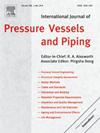SUS316焊缝残余应力有限元模拟中退火温度的研究
IF 3
2区 工程技术
Q2 ENGINEERING, MECHANICAL
International Journal of Pressure Vessels and Piping
Pub Date : 2025-05-17
DOI:10.1016/j.ijpvp.2025.105557
引用次数: 0
摘要
研究了奥氏体不锈钢(SUS316)焊接过程中应变硬化的再结晶现象,提出了适合有限元模拟的退火温度。对表面加工后的1道焊缝进行电子背散射衍射(EBSD)分析结果表明,由于焊接热循环引起的再结晶现象,可以引入退火效应。因此,有必要在有限元模拟中引入合适的退火温度来模拟这一现象。为了确定合适的退火温度,将20%和30%预应变冷轧试样置于800 ~ 1300℃的峰值温度下,在峰值温度下保持1 s,并测量相应的硬度。结果表明,当退火温度约为1050℃时,得到的硬度与固溶处理后的硬度一致。为了验证所提出的退火温度在有限元模拟中的准确性,将此确定的退火温度(1050℃)应用于有限元模型中,估算7层焊接后的残余应力,并通过测量验证结果。模拟残余应力与实测结果吻合较好,说明有限元模拟中提出的1050℃退火温度是合理有效的。因此,今后在SUS316焊接有限元模拟中应纳入1050℃的退火温度。本文章由计算机程序翻译,如有差异,请以英文原文为准。
A study on annealing temperature in FEM simulation of residual stress in SUS316 weld
This study investigates the recrystallization phenomenon of strain hardening during welding process in austenitic stainless steel (SUS316), and a suitable annealing temperature for finite element method (FEM) simulation was proposed. The electron backscatter diffraction (EBSD) analysis results of a 1-pass weld with prior surface machining proved that the annealing effect can be introduced owing to the recrystallization phenomenon caused by welding thermal cycle. Therefore, it was necessary to introduce a suitable annealing temperature into the FEM simulation to simulate this phenomenon. To establish a propriate annealing temperature, the 20 % and 30 % pre-strained cold-rolled specimens were subjected to peak temperatures ranging from 800 °C to 1300 °C, held at the peak temperature for 1 s, and their corresponding hardness was measured. The results showed that when the annealing temperature is approximately 1050 °C, the resulting hardness aligns with that of solution-treated specimens. To verify the accuracy of the proposed annealing temperature in the FEM simulation, this determined annealing temperature (1050 °C) was then applied in the FEM model to estimate the residual stress after 7-layer welding, with the results validated through measurements. The good agreement between the simulated residual stress and the measured results follows that the proposed annealing temperature of 1050 °C in FEM simulation is reasonable and effective. Therefore, the annealing temperature of 1050 °C should be included in the FEM simulation of SUS316 welding in the future.
求助全文
通过发布文献求助,成功后即可免费获取论文全文。
去求助
来源期刊
CiteScore
5.30
自引率
13.30%
发文量
208
审稿时长
17 months
期刊介绍:
Pressure vessel engineering technology is of importance in many branches of industry. This journal publishes the latest research results and related information on all its associated aspects, with particular emphasis on the structural integrity assessment, maintenance and life extension of pressurised process engineering plants.
The anticipated coverage of the International Journal of Pressure Vessels and Piping ranges from simple mass-produced pressure vessels to large custom-built vessels and tanks. Pressure vessels technology is a developing field, and contributions on the following topics will therefore be welcome:
• Pressure vessel engineering
• Structural integrity assessment
• Design methods
• Codes and standards
• Fabrication and welding
• Materials properties requirements
• Inspection and quality management
• Maintenance and life extension
• Ageing and environmental effects
• Life management
Of particular importance are papers covering aspects of significant practical application which could lead to major improvements in economy, reliability and useful life. While most accepted papers represent the results of original applied research, critical reviews of topical interest by world-leading experts will also appear from time to time.
International Journal of Pressure Vessels and Piping is indispensable reading for engineering professionals involved in the energy, petrochemicals, process plant, transport, aerospace and related industries; for manufacturers of pressure vessels and ancillary equipment; and for academics pursuing research in these areas.

 求助内容:
求助内容: 应助结果提醒方式:
应助结果提醒方式:


